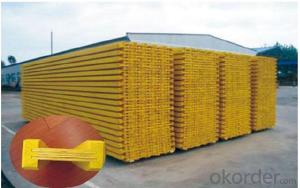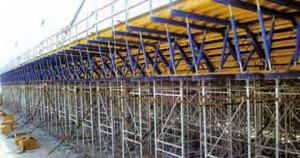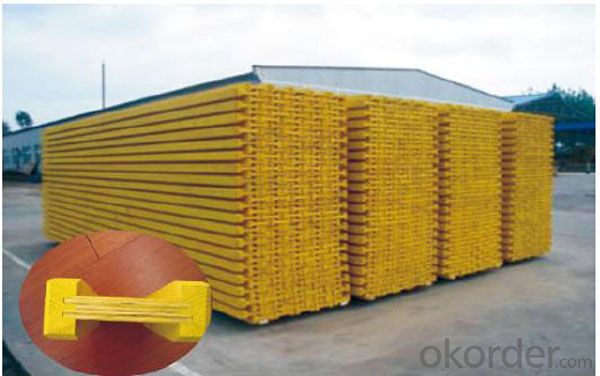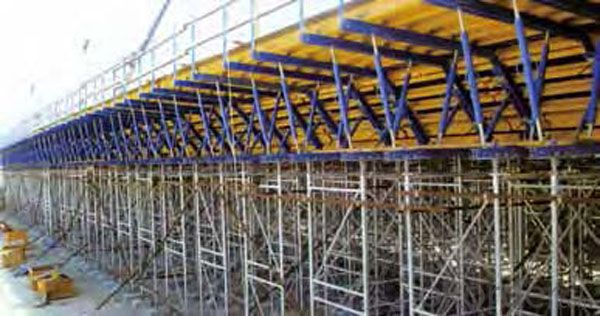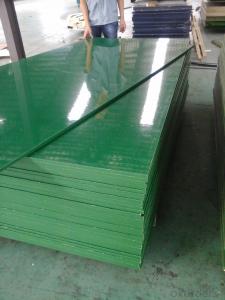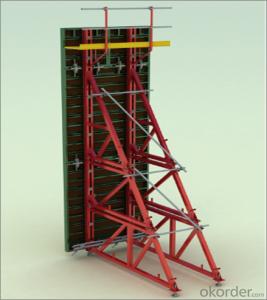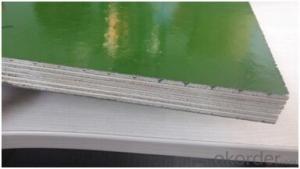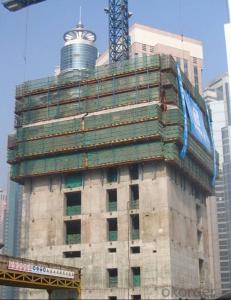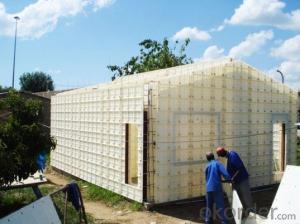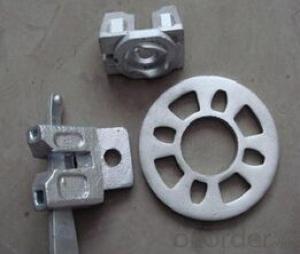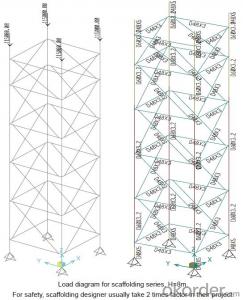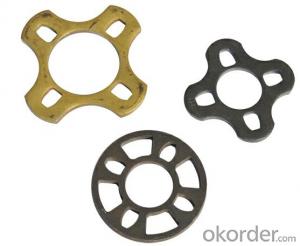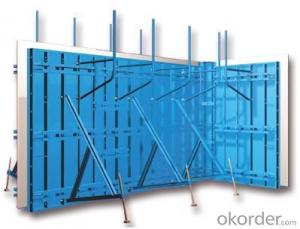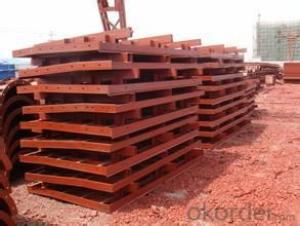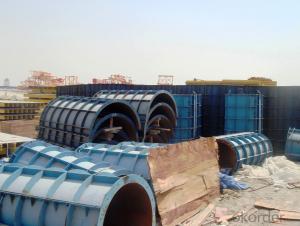Used Construction Scaffolding Formwork Ringlock Scaffolding Rosette for Wholesales
- Loading Port:
- Tianjin
- Payment Terms:
- TT OR LC
- Min Order Qty:
- 10000 set
- Supply Capability:
- 50000 set/month
OKorder Service Pledge
OKorder Financial Service
You Might Also Like
Used Construction Scaffolding Formwork Ringlock Scaffolding Rosette for Wholesales
Frame Scaffolding Systems Formwork Bs Standard Scaffolding Tube With Low Price
Developing with new technology materials, steel formworks is no longer a must in construction concrete process. More and more buildings are established with plastic formworks. And workers love this new formworks much more.
The advantages of plastic formworks:
1.First of all--light
Yes it is the first advantage of plastic formwork. It wins the great praise of both contractors and workers.
The biggest panel is 120×1500px,weights 10.5kg only. It can be lift and set up by one person easily, which means there is no need for cranes on site.Saves a lot of cost and time.
2.Easy set up
Different size of panels can firmly locked by simply turn the special handles to 90 degree. The Panels has rib on the back, which makes the system need not traditional wood blocks and nails. The panels have holes to fit tie rod, guarantee the strength of the whole system.
3.Modularity
Modular formworks composed by different size of panels,the main item is 120×1500px panel,which is used for the large area of walls and slabs. There are also small size of panels like 10×1500px,20×1500pxcm,25×1500px,inner corner 20×20×1500px and outer corner 10×5×1500px.Due to the variety of panel size, the system can form almost all size walls 120×1500px panel of multiply by 125px. The material of modular formwork is PC-ABS mixed with special glass fibers which enable panels to hold high pressures.
4.Strength
The handles are made by high strength Nilon, each panel locked by at least 4 handles, which makes the whole system strong enough to pour 1000px walls.
5.Environment friendly
The system needs no cut and nail due to the variety size. Also it needs nearly no wood. The material can be recycled after broken, so it will not pollute the environment.
6.Consequent
Concrete does not stick to plastic formwork, thus the panels need no oil before using, and can be cleaned simply by water. The surface of the wall which build by modular formwork is smooth and without rework.
Used Construction Scaffolding Formwork Ringlock Scaffolding Rosette for Wholesales
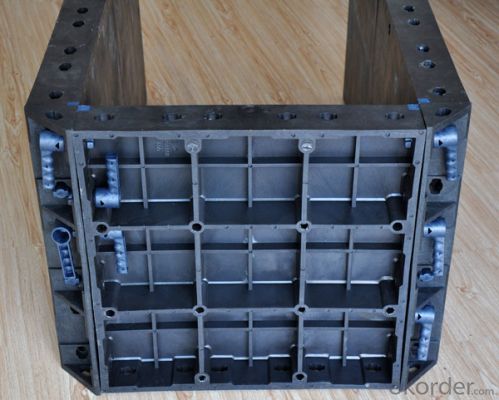
Used Construction Scaffolding Formwork Ringlock Scaffolding Rosette for Wholesales
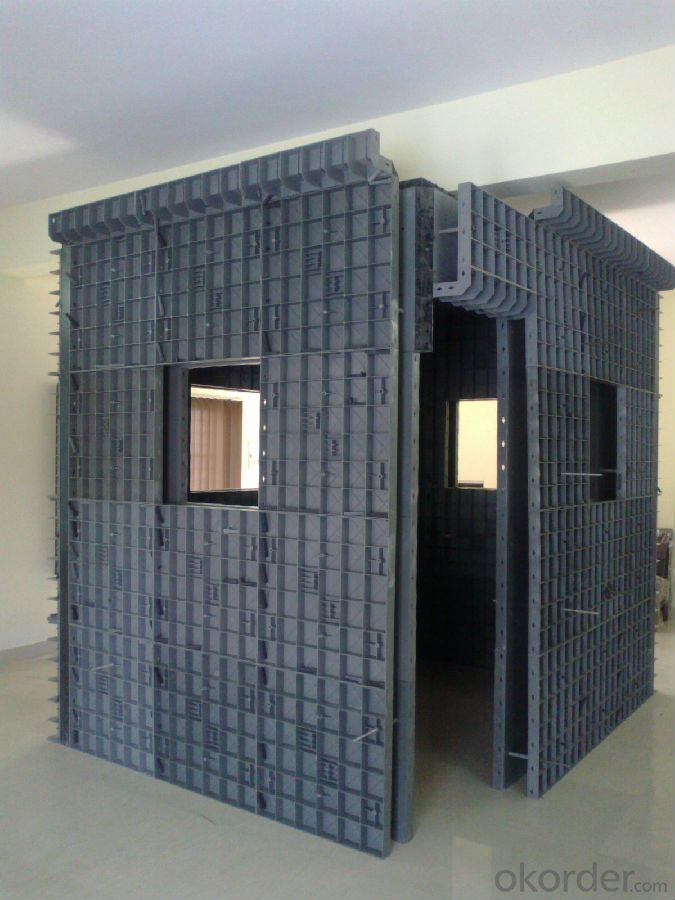
Used Construction Scaffolding Formwork Ringlock Scaffolding Rosette for Wholesales
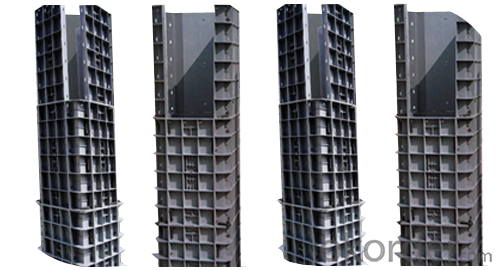
Advantage
* Good loading capacity
* Easy to assemble and dismantle
* Stable and durable thanks to its structual design & automatic welding quality
* Customized solution helps you work safe, save cost and convenient
* Excellent quality for formwork & scaffolding with wide choices
Used Construction Scaffolding Formwork Ringlock Scaffolding Rosette for Wholesales
Packing
in bulk or in bundle, or as requested
Shipping
15-20 Days.
Normally small orders, it needs just 15-20 business days to the port. For goods with stock, it would be even shoter.
Other scaffolding & formwork products:
(1) Scaffolding System:
Including Ringlock Scaffolding System and accessories; Cuplock Scaffolding System and accessories; Kwikstage Scaffolding System and accessories; Haki Scaffolding System and accessories;
(2) Scaffolding Frame & Accessories:
Including Walk Through Frame Scaffolding; Ladder Frame Scaffolding; Accessories; we also can make scaffolding according to your samples or drawings.
(3) Scaffolding Couplers/Clamps:
We can produce all kinds of forged and pressed couplers, including British type couplers, American type couplers, German type couplers, Italian type couplers ,fence couplers, BRC coplers and so on. We also can produce according to your drawings or samples.
(4) Formwork System Scaffolding & Accessories:
Light Duty Shoring prop and Heavy Duty Shoring Prop; Wing nuts and Tie rods; RASTO clamp and so on.
FAQ Used Construction Scaffolding Formwork Ringlock Scaffolding Rosette for Wholesales
Why Us?
We are one of the Top 500 in the world, largest construction materials supplier in China. Also we are a state-owned company and respond to every customer with large and also small orders.
We own professional manufacturers with powerful producing capacity.
Extensive and comprehensive quality control system
Excellent products with competitive prices.
Efficient services in pre and after sale.
Full energy with affluent experience team.
- Q: Does steel frame formwork require any specific concrete pouring techniques?
- Yes, steel frame formwork does require specific concrete pouring techniques. This is because the steel frame formwork system is designed to provide support and structure during the pouring and curing of concrete. Firstly, it is important to ensure that the formwork is properly aligned and secured before pouring the concrete. This will help to prevent any leakage or distortion during the pouring process. The formwork should be checked for any gaps or spaces that may cause concrete to seep through. Secondly, the concrete pouring technique should be carefully planned to ensure uniform distribution and consolidation of the concrete within the formwork. This can be achieved by using appropriate pouring methods such as the continuous pour, where the concrete is poured continuously in a single operation, or the layer-by-layer pour, where the concrete is poured in multiple layers and compacted in between. Additionally, it is important to use appropriate vibration techniques to eliminate air pockets and ensure proper compaction of the concrete. Vibrators can be used to achieve this, either by hand-held or mechanical methods, depending on the size and complexity of the formwork. Furthermore, proper curing techniques should be employed to facilitate the hardening and strength development of the concrete. This can involve measures such as covering the formwork with a curing membrane or applying a curing compound to maintain moisture and temperature levels. In summary, steel frame formwork does require specific concrete pouring techniques to ensure the structural integrity and quality of the finished concrete structure. Proper alignment, uniform pouring, compaction, and curing techniques are essential for achieving the desired results.
- Q: What are the different methods of leveling and adjusting steel frame formwork?
- There are several methods of leveling and adjusting steel frame formwork, depending on the specific requirements of the construction project. Some of the most common methods include: 1. Jacking system: This method involves using hydraulic jacks to adjust the formwork to the desired level. The jacks are placed at strategic points along the frame and can be easily controlled to raise or lower the formwork as needed. 2. Wedges: Wedges are commonly used to level and adjust steel frame formwork. They are placed under the formwork at specific points and can be driven in or removed to achieve the desired level. Wedges offer a simple and effective way to make incremental adjustments. 3. Shims: Shims are thin, tapered pieces of material that are used to level and adjust formwork. They are typically made of metal or plastic and are placed between the formwork and the supporting structure to create a level surface. Shims can be stacked or removed as needed to achieve the desired level. 4. Screw jacks: Screw jacks are similar to hydraulic jacks but operate using a threaded rod mechanism. They can be easily adjusted by turning the rod clockwise or counterclockwise to raise or lower the formwork. Screw jacks are commonly used in conjunction with other leveling methods to fine-tune the formwork. 5. Leveling plates: Leveling plates are flat, steel plates that are used to distribute the load and level the formwork. They are placed under the formwork at strategic points and can be adjusted by adding or removing shims or wedges. Leveling plates provide a stable base for the formwork and ensure even distribution of weight. 6. Laser leveling: Laser leveling is a more advanced method that utilizes laser technology to achieve precise leveling. A laser level is set up at a reference point, and the formwork is adjusted based on the laser beam. This method is highly accurate and efficient, but it requires specialized equipment and expertise. In conclusion, there are various methods of leveling and adjusting steel frame formwork, ranging from simple manual techniques to advanced laser leveling. The choice of method depends on factors such as the project requirements, available resources, and desired level of accuracy.
- Q: How does steel frame formwork accommodate for different concrete pouring rates?
- Steel frame formwork can accommodate for different concrete pouring rates by providing a sturdy and adjustable structure. The steel frames can be easily assembled and disassembled, allowing for quick adjustments in formwork placement. This flexibility allows contractors to adapt the formwork to different pouring rates, ensuring a smooth and efficient concrete pouring process. Additionally, steel frame formwork is designed to withstand the pressure exerted by the concrete, ensuring stability and preventing any deformations that could affect the pouring rate.
- Q: Are there any environmental considerations associated with steel frame formwork?
- Yes, there are several environmental considerations associated with steel frame formwork. Firstly, the production of steel involves a significant amount of energy and resources. The extraction of iron ore, processing it into steel, and the transportation of steel all contribute to carbon emissions and environmental degradation. This makes the production of steel frame formwork a carbon-intensive process. Additionally, steel is not a renewable resource. It is extracted from the earth's crust and once it is used, it cannot be easily replenished. This raises concerns about the depletion of natural resources and the long-term sustainability of using steel frame formwork. Furthermore, steel is prone to corrosion, especially when exposed to moisture or chemicals. This can lead to the deterioration of the formwork over time, resulting in the need for replacements and repairs. The disposal of old or damaged steel formwork also poses environmental challenges, as it can contribute to landfill waste. On a positive note, steel frame formwork can be reused multiple times, which helps reduce the overall environmental impact. However, the transportation and handling of the heavy steel frames can still result in additional carbon emissions. To mitigate these environmental considerations, it is important to consider alternative materials for formwork, such as recycled plastic, bamboo, or timber. These materials are renewable, have lower carbon footprints, and can be reused or recycled more easily. Additionally, implementing sustainable practices in the construction industry, such as reducing waste, optimizing design, and improving energy efficiency, can help minimize the environmental impact associated with steel frame formwork.
- Q: What are the common maintenance practices for steel frame formwork systems?
- To maintain steel frame formwork systems, it is important to regularly clean and inspect them, lubricate their moving parts, and repair or replace any damaged components. Cleaning is a crucial maintenance practice that involves removing any debris, concrete residue, or other materials that may have accumulated on the frames and panels. By regularly cleaning the formwork system, you can prevent corrosion and ensure its overall good condition. Inspection is another essential maintenance practice. It involves thoroughly examining the formwork system for any signs of damage or wear. This includes inspecting the frame, panels, connecting hardware, and other components for cracks, dents, or loose parts. It is important to conduct inspections before and after each use, as well as periodically during long projects. If any issues are detected during the inspection, they should be promptly addressed to prevent further damage. Lubrication is necessary for the smooth operation of the moving parts in a steel frame formwork system. This includes applying lubrication to hinges, locks, and other mechanisms to ensure their proper functioning. By lubricating these parts, you can reduce friction and wear, which in turn can extend the lifespan of the formwork system and enhance its performance. Repairing or replacing damaged components is crucial for maintaining the integrity of the steel frame formwork system. Any components that are cracked, bent, or otherwise damaged should be repaired or replaced as soon as possible. This may involve replacing worn-out panels, repairing damaged frames, or replacing faulty hardware. Regular inspections and prompt repair or replacement of damaged components can prevent accidents and help ensure that the formwork system remains safe and reliable. To summarize, common maintenance practices for steel frame formwork systems include regular cleaning and inspection, lubrication of moving parts, and repair or replacement of damaged components. By following these practices, you can ensure the longevity and proper functioning of the formwork system, promoting safety and efficiency on construction sites.
- Q: Can steel frame formwork be easily dismantled and recycled?
- Yes, steel frame formwork can be easily dismantled and recycled. Steel is a highly recyclable material, and its strength and durability make it ideal for reuse in various construction projects. The dismantling process is relatively straightforward, allowing the steel frame formwork to be easily disassembled and separated for recycling purposes. This promotes sustainability and contributes to the circular economy by reducing waste and conserving resources.
- Q: What are the different types of formwork hooks used in steel frame formwork systems?
- Steel frame formwork systems utilize various types of formwork hooks, each serving a specific purpose and function. Common examples include: 1. Wedge Hooks: These hooks are employed to fasten formwork panels to the steel frame. By inserting them into slots on the frame and tightening them with a wedge, a secure connection is established between the panel and the frame. 2. Flat Hooks: Horizontal connection between formwork panels is accomplished with flat hooks. Featuring a flat design with a hook at one end, they can be easily inserted into panel slots and locked in place. 3. Angle Hooks: Similar to flat hooks, angle hooks possess a bent or angled design. They are utilized to connect formwork panels at corners or angles, ensuring a strong and stable connection. 4. Brace Hooks: Diagonal braces are secured to the formwork system using brace hooks. These hooks are inserted into frame slots and tightened with a wedge or locking mechanism, guaranteeing a secure attachment. 5. Connecting Hooks: For vertical joining of two or more formwork frames, connecting hooks are utilized. They are inserted into frame slots and tightened with a wedge or locking mechanism, establishing a robust connection between the frames. 6. Lifting Hooks: To lift and relocate formwork panels or frames, lifting hooks are employed. Typically attached to the top or sides of the panels, they provide a secure point for crane or lifting equipment usage. These examples illustrate the diverse range of formwork hooks employed in steel frame formwork systems. The particular hook type chosen depends on the formwork system's design, requirements, and the specific demands of the project at hand.
- Q: How does steel frame formwork handle the placement of MEP (mechanical, electrical, plumbing) systems within the concrete structure?
- The versatility and efficiency of steel frame formwork make it an excellent choice for accommodating MEP systems in concrete structures. The sturdy steel frames provide reliable support, allowing for seamless integration of MEP components. One of the main advantages of steel frame formwork is its adaptability. The frames can be easily customized to meet the specific requirements of MEP systems, including creating openings for pipes, conduits, and ducts. This flexibility ensures that MEP systems can be incorporated efficiently without compromising the integrity of the concrete structure. In addition, steel frame formwork offers exceptional load-bearing capabilities, which is crucial considering the weight and potential vibrations associated with MEP systems. The strong and durable steel frames can withstand the weight and movement of MEP components, providing a stable platform for their installation. Furthermore, steel frame formwork allows for precise placement of MEP systems. The frames can be easily aligned and leveled, ensuring accurate installation. This is especially important in complex MEP installations to avoid clashes between different systems. Moreover, steel frame formwork simplifies the installation and maintenance of MEP systems. The frames provide easy access to the components, facilitating convenient installation, inspection, and maintenance. This accessibility allows for efficient repairs and modifications, reducing downtime and minimizing disruptions to the concrete structure. In conclusion, steel frame formwork is an efficient and effective system for integrating MEP systems into concrete structures. Its adaptability, load-bearing capabilities, precision, and accessibility make it an ideal choice for seamless integration of MEP components.
- Q: What are the different types of coatings or surface treatments applied to steel frame formwork?
- There are several types of coatings or surface treatments that can be applied to steel frame formwork. Some common options include galvanization, epoxy coatings, powder coatings, and paint. Galvanization involves applying a layer of zinc to the steel surface, which provides corrosion resistance. Epoxy coatings create a protective barrier against chemicals and moisture. Powder coatings offer durability and resistance to chipping, scratching, and fading. Paint can be used for aesthetic purposes or to provide a basic level of protection. The choice of coating or surface treatment depends on the specific requirements of the project, including the desired level of corrosion resistance, durability, and appearance.
- Q: What are the key considerations for selecting the appropriate steel frame formwork system for complex structures?
- When selecting the appropriate steel frame formwork system for complex structures, there are several key considerations to keep in mind. First and foremost, it is important to assess the specific requirements and complexity of the structure. This includes factors such as the size, shape, and height of the structure, as well as any unique design features or challenges that may be present. Understanding the complexity of the structure will help determine the level of flexibility, adaptability, and customization required from the formwork system. Next, the load-bearing capabilities of the formwork system must be carefully evaluated. Complex structures often involve heavier loads and increased stresses, so it is crucial to select a steel frame formwork system that can handle the expected loads effectively and safely. This includes considering factors such as the strength, rigidity, and stability of the system. Another important consideration is the ease of assembly and disassembly of the formwork system. Complex structures often require intricate formwork configurations, so selecting a system that is easy to assemble and adjust will significantly improve productivity and efficiency on site. Additionally, the formwork system should have the capability to accommodate any necessary modifications or alterations during the construction process. The durability and lifespan of the formwork system should also be taken into account. Complex structures typically involve extended construction periods, so selecting a steel frame formwork system that is durable and can withstand prolonged use without compromising its structural integrity is essential. This includes considering factors such as the quality of materials, corrosion resistance, and maintenance requirements. Finally, cost-effectiveness is an important consideration. While complex structures may require specialized formwork systems, it is crucial to evaluate the cost-benefit ratio and select a system that offers the best value for money in terms of performance, durability, and productivity. In summary, when selecting the appropriate steel frame formwork system for complex structures, key considerations include assessing the complexity of the structure, evaluating load-bearing capabilities, considering ease of assembly and disassembly, ensuring durability and lifespan, and maintaining cost-effectiveness.
Send your message to us
Used Construction Scaffolding Formwork Ringlock Scaffolding Rosette for Wholesales
- Loading Port:
- Tianjin
- Payment Terms:
- TT OR LC
- Min Order Qty:
- 10000 set
- Supply Capability:
- 50000 set/month
OKorder Service Pledge
OKorder Financial Service
Similar products
Hot products
Hot Searches
